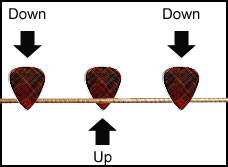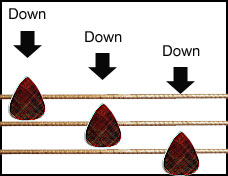Alternate picking is said to provide more sustain and tone control, as stated by guitar legends such as Steve Morse. This type of picking pattern takes more time to learn than natural picking patterns such as directional picking. Most guitar players seek to use a hybrid of the two picking patterns instead, so the best of both worlds may be enjoyed.

Alternate picking is an easy concept to grasp, but much harder to put into proper use. The idea behind alternate picking is to alternate picking directions with each sounded note. This means that after every down stroke of the pick, there is an up stroke as well. Beginners will find this to be a little hard to do at first, but it will eventually lead to an easier method to learn tremolo picking. It also makes most rhythms much easier to play, and faster. The downside to alternate picking is the arpeggio. An arpeggio incorporates multiple strings, so staying with the alternate picking pattern will also decrease speed.
Alternate picking vs. direct picking
The main argument between alternative and direct picking is speed. Direct picking pattern supporters claim that the shortest distance between two points is a straight line. This is true, but so is the fact that the guitar pick almost always surpasses the guitar string on a down stroke. So it is usually much faster to pluck the string again while returning to the original position. This lets speed be taken to the next level, but as stated before, it doesn’t work so well for multiple string arpeggios.

The majority of self-taught guitar players will of course use directional picking- as it is the natural way to play. Alternate picking does have its benefits for those who require speed, so it is usually learned after directional picking is picked up. Of course, there are guitar legends that stick to both picking styles- so neither group is necessarily right or wrong. In fact, the best way to go is to achieve a hybrid sense of picking. In a hybrid picking between alternate and direct picking, both picking styles are used for what they do best. Direct picking can allow guitar players to play arpeggios, and also play crtain rhythms faster. Alternate picking can allow amazing speeds to be achieved through practice- as long as the rhythm is based around only a few strings at most.

Economy picking
With the fusion of alternate and direct picking, comes the term economy picking. Economy picking is usually the best way to get the best speed from both picking methods. If the next note to be played lies on another string, it obviously shouldn’t incorporate alternative picking. Each change of string brings another direct pick technique. If there are a few notes located on one particular string, then alternate picking should be used if necessary.
Those who are new to the guitar shouldn’t be afraid to learn the alternate picking technique. It is usually what fast types of music such as metal rely on. Learning it can be tough especially without a teacher to act as a guide, and it will take some time to master. But guitar legends such as John Petrucci can attest to the fact that alternate picking is just as important as direct picking.
Nive Post. I am a huuge fan of alsternate picking. Especially when playing on one string. Some times i use economy when i am playing over a few strings. But since i have been getting into bluegrass i am really trying to stick to straight alternate.
Did you ever see my video lesson on alternate picking? http://theguitarresource.com/technique/alternate-picking-video-lesson/
it may help. at least i hope so 🙂
nice post!
Great post. It’s awesome that people are taking the time to help each other out. If people
Want to check out some good alternate picking stuff look into Al Dimeola’s book or Charlie Wallace’s Guitar Burning Speed program. Great stuff!
Alternate picking should always be preferred, but in my opinion you’re missing one key reason for it: Timing.
Down pick on the beats and up pick off the beats, this will force you to “feel” the downbeat when playing 8th notes. Therefore, for heavily syncopated rhythms, you’d be using mainly up strokes.
Down, up, down, down, up, down, etc. will allow you to feel triplets.
My main argument against economy picking is this, it’s much harder to feel where the pulse of the music is.
economy picking requires more forethought than strict alternate picking, which renders it virtually useless in impovisational passages.
Nice article. Thank you.
I learned down-picking, up-picking, alternate picking, economy picking and finally downward pick-slanting, upward pick-slanting and combination pick-slanting. I practiced them all until they were second nature. Now, my picking follows whatever the feel of the phrase needs. I switch from one to the other without thinking about it.
When you are learning to speak, you learn all of the techniques for the sounds. At some point, you begin to say what’s on your mind without thinking about what your lips, teeth and tongue need to do to make it happen.
In addition to the above-listed techniques, hybrid picking opens the door to new options, and for triplets learn: down > with up hammer-on, and up > with down pull-off, to allow you to keep alternate picking when mixing trips with straight-time phrases.
I could do a better job with my legato, and sweep picking, but I’ve only been playing for 54 years and still have a way to go… Keep picking!
Just learn and use both.